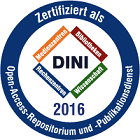Hansen, Aylin: Investigation of BRD9 inhibition as alternative treatment option for testicular germ cell tumors. - Bonn, 2025. - Dissertation, Rheinische Friedrich-Wilhelms-Universität Bonn.
Online-Ausgabe in bonndoc: https://nbn-resolving.org/urn:nbn:de:hbz:5-85214
Online-Ausgabe in bonndoc: https://nbn-resolving.org/urn:nbn:de:hbz:5-85214
@phdthesis{handle:20.500.11811/13603,
urn: https://nbn-resolving.org/urn:nbn:de:hbz:5-85214,
author = {{Aylin Hansen}},
title = {Investigation of BRD9 inhibition as alternative treatment option for testicular germ cell tumors},
school = {Rheinische Friedrich-Wilhelms-Universität Bonn},
year = 2025,
month = oct,
note = {Type II germ cell tumors are the most prevalent tumor in young men between the ages of 15 and 35 years. They arise from a block in primordial germ cell differentiation leading to a precursor lesion called germ cell neoplasia in situ (GCNIS). They are subgrouped into seminomas and non-seminomas. Non-seminomas comprise embryonal carcinomas which are able to differentiate into cells of all three germ layers as well as extraembryonic tissue classified as teratoma, yolk sac tumor and choriocarcinoma.
The standard treatment of testicular germ cell tumors (TGCT) is orchiectomy followed by cisplatin-based chemotherapy leading to high 5-year survival rates of 95 % but unfortunately 15-20 % of patients are still resistant to the treatment. Therefore, we found it very important to investigate alternative treatment options like epigenetic drugs. BET protein inhibitors interfering with the epigenetic landscape have already been shown to be effective in different cancer types like prostate cancer, glioblastoma and breast cancer. The bromodomain-containing protein-9 (BRD9) is part of a chromatin remodeling complex and an epigenetic reader which binds to acetylated lysine residues to activate gene expression by recruitment of other transcription factors. BRD9 shows significantly increased protein levels in cervical cancer and in malignant rhabdoid tumor (MRT) cells. For example, in acute myeloid leukemia (AML) cells the inhibition of BRD9 led to reduction of cell growth. Therefore, we found it very interesting to investigate the effect of the BRD9 inhibitor I-BRD9 in TGCTs.
First, we analyzed the expression of the target BRD9 in TGCT tissues and cell lines. Meta-analysis of microarray data in tissues as well as cell lines showed expression of BRD9. On protein level Western Blot also revealed comparable protein levels in TGCT cell lines while a tissue microarray (TMA) showed heterogenous expression of BRD9 in TGCT tissues. On the other hand, the lowest expression was found in the control cell line MPAF and in normal testis tissue indicating a promising starting point for testing the BRD9 inhibitor in TGCTs. XTT viability assays after I-BRD9 application led to reduced cell growth in all TGCT cells while the control cells were only slightly affected. FACS analysis revealed induction of apoptosis as well as G1-phase cell cycle arrest already after 24 hours of treatment with I-BRD9 in the TGCT cell lines while the control cells remained unaffected. RNAseq analysis displayed downregulation of a prominent network of pluripotency markers including NANOG, NODAL and KLF4 while genes involved in epithelium development were upregulated. These data suggest loss of the pluripotency state and differentiation towards an epithelial cell fate. Taken together, the BRD9 inhibitor I-BRD9 led to severe effects in TGCT cell lines like reduction of viability, induction of apoptosis and G1-phase cell cycle arrest while the control cells were only slightly affected. BRD9 inhibition induces loss of the pluripotency state and differentiation towards an epithelial cell fate. Most importantly, the data suggest I-BRD9 as a potential treatment alternative for TGCTs.},
url = {https://hdl.handle.net/20.500.11811/13603}
}
urn: https://nbn-resolving.org/urn:nbn:de:hbz:5-85214,
author = {{Aylin Hansen}},
title = {Investigation of BRD9 inhibition as alternative treatment option for testicular germ cell tumors},
school = {Rheinische Friedrich-Wilhelms-Universität Bonn},
year = 2025,
month = oct,
note = {Type II germ cell tumors are the most prevalent tumor in young men between the ages of 15 and 35 years. They arise from a block in primordial germ cell differentiation leading to a precursor lesion called germ cell neoplasia in situ (GCNIS). They are subgrouped into seminomas and non-seminomas. Non-seminomas comprise embryonal carcinomas which are able to differentiate into cells of all three germ layers as well as extraembryonic tissue classified as teratoma, yolk sac tumor and choriocarcinoma.
The standard treatment of testicular germ cell tumors (TGCT) is orchiectomy followed by cisplatin-based chemotherapy leading to high 5-year survival rates of 95 % but unfortunately 15-20 % of patients are still resistant to the treatment. Therefore, we found it very important to investigate alternative treatment options like epigenetic drugs. BET protein inhibitors interfering with the epigenetic landscape have already been shown to be effective in different cancer types like prostate cancer, glioblastoma and breast cancer. The bromodomain-containing protein-9 (BRD9) is part of a chromatin remodeling complex and an epigenetic reader which binds to acetylated lysine residues to activate gene expression by recruitment of other transcription factors. BRD9 shows significantly increased protein levels in cervical cancer and in malignant rhabdoid tumor (MRT) cells. For example, in acute myeloid leukemia (AML) cells the inhibition of BRD9 led to reduction of cell growth. Therefore, we found it very interesting to investigate the effect of the BRD9 inhibitor I-BRD9 in TGCTs.
First, we analyzed the expression of the target BRD9 in TGCT tissues and cell lines. Meta-analysis of microarray data in tissues as well as cell lines showed expression of BRD9. On protein level Western Blot also revealed comparable protein levels in TGCT cell lines while a tissue microarray (TMA) showed heterogenous expression of BRD9 in TGCT tissues. On the other hand, the lowest expression was found in the control cell line MPAF and in normal testis tissue indicating a promising starting point for testing the BRD9 inhibitor in TGCTs. XTT viability assays after I-BRD9 application led to reduced cell growth in all TGCT cells while the control cells were only slightly affected. FACS analysis revealed induction of apoptosis as well as G1-phase cell cycle arrest already after 24 hours of treatment with I-BRD9 in the TGCT cell lines while the control cells remained unaffected. RNAseq analysis displayed downregulation of a prominent network of pluripotency markers including NANOG, NODAL and KLF4 while genes involved in epithelium development were upregulated. These data suggest loss of the pluripotency state and differentiation towards an epithelial cell fate. Taken together, the BRD9 inhibitor I-BRD9 led to severe effects in TGCT cell lines like reduction of viability, induction of apoptosis and G1-phase cell cycle arrest while the control cells were only slightly affected. BRD9 inhibition induces loss of the pluripotency state and differentiation towards an epithelial cell fate. Most importantly, the data suggest I-BRD9 as a potential treatment alternative for TGCTs.},
url = {https://hdl.handle.net/20.500.11811/13603}
}






